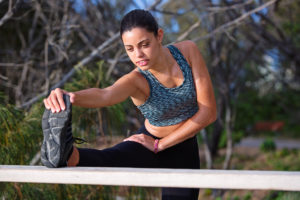
Sports medicine research has called into question the value of warm-ups and cool-downs, and cast doubt on whether they really prevent muscle soreness.
However, there are still other benefits to these pre- and post-workout steps, and to stretching after both. But it’s important to get the sequence right.
Our Take
Dynamic stretching is often confused with ballistic stretching, which is forceful, repetitive movement beyond the normal range of motion. The problem with ballistic stretching is it doesn’t allow the muscle to relax or adjust to its new range.
The benefits of dynamic stretching:
- It relaxes muscles during brief and intense movement, allowing for elongation of the muscle without straining.
- It improves peak force of muscle.
- It improves the rate of force during muscle contraction.
- It improves core temperature and muscle temperature.
- It reduces the chance of injury.
If you’re performing a dynamic movement such as running or jumping, it makes sense to perform dynamic stretches beforehand.
Static stretching is the most common way to stretch. Focusing on a particular muscle or joint, an athlete will maintain a position beyond the normal range for an extended period of time.
Static stretching can improve flexibility and overall length and tone of a muscle. It makes sense to perform static stretches after an activity—during the cool-down phase—although these types of stretches can also be effective if they’re done an hour before competition or training.
Some athletes will jog first to raise their core temperature, making it easier to stretch their muscles.
A warm-up preps your body for exercise by increasing your heart rate and blood flow to your muscles. It doesn’t have to be complicated. Just do an easy 5 to 10 minutes of your chosen activity or of easy walking. By raising your heart rate at a gradual pace, the warm-up helps minimize stress on your heart.
Once your muscles are warm, they’re ready for stretching. Stretches can be static or dynamic. With static stretching, you hold each position for about 10 to 30 seconds. With dynamic stretching, you move through a full range of motion.
Either way, stretching increases flexibility, which becomes even more important as you age so that you can maintain agility and balance. Some studies show that dynamic stretching is better before exercise, and static is better afterward.
After your workout is complete, a cool-down helps your heart rate return to normal, again at a gradual pace. You can perform your aerobic activity at a slow pace or, again, simply walk for about 5 minutes or until your heart rate goes below 120 beats per minute.
While your body is still warm, you want to do static stretches. Repeat each one two to four times, remembering to breathe in and out as you hold each position.
 /a>
/a>
 /a>
/a>
 /a>
/a>